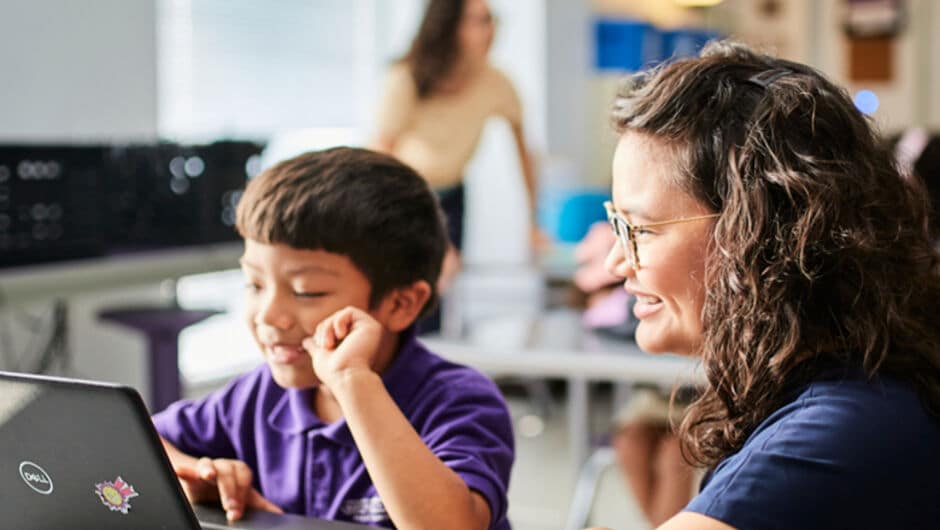
The Fight to Keep English Learners From Falling Through the Cracks
COVID-19 has taken an unprecedented toll on English learners. Families, educators, and school leaders are giving their all to keep them on track.
As a high school junior, Scarlette Irias had to worry about maintaining her good grades for college applications and keeping up with her IT certification program, all while adjusting to remote instruction. But when Scarlette’s aunt asked her if she could help her 9-year-old cousin Gerlin with school, she knew she’d make the time to help.
Gerlin emigrated from Honduras to Miami, Fla., two years ago, and he was adjusting to Van E. Blanton Elementary as an English language learner. But the pandemic interrupted his progress. Gerlin began to struggle with his schoolwork and English.
“I can relate to it because I lived in my parent's country, El Salvador, before. I went to school there,'' Scarlette said. “Once I got back to the U.S., I had to be an ESL kid first.”
And so Scarlette would sit Gerlin at her round kitchen table and supervise him. She’d assist Gerlin with his math homework, helping him to learn the concepts in Spanish before translating them to English. And when Gerlin had trouble keeping up with certain units in school, she would call his teachers for help. Above all else, Scarlette would remind Gerlin about why his success in school matters.
“You got to prove to them that you can do it,” Scarlette would tell Gerlin when he doubted himself and had trouble focusing. “You got to prove it to everybody — to the people from our family and our country — that you can do it.”
Scarlette knew what was at stake. She knew how much her aunt had sacrificed to support her son’s future, and Scarlette wasn’t about to let her family down, even during a pandemic.

The Challenges English Learners Faced Before and After COVID-19
Scarlette and her relatives aren’t the only ones who are worried about the impacts of the pandemic and remote learning on students like Gerlin.
At the start of the pandemic, Miami-Dade County Public Schools took a multifaceted approach to supporting students’ most basic needs and facilitating a smooth transition to remote learning: food distribution; help desks manned by English, Spanish, and Haitian Creole speakers; a big investment into SEL training for teachers; extended summer sessions; home visits to students who were disengaged and absent; and more.
Now, helping vulnerable student populations like English learners catch up after months of hardship and learning disruptions is one of the district’s top focuses, according to Ana M. Gutierrez, the administrative director at Miami-Dade County Public Schools’ Department of Bilingual Education and World Languages.

Many families and educators are concerned about the pandemic’s damage to the progress English learners have made in schools, said Stephany Cuevas, an assistant professor of education in the Attallah College of Educational Studies at Chapman University.
It is too soon to know the full extent of learning loss among ELs nationally, but the organization Policy Analysis for California Education has found that learning loss has been more dramatic for ELs than their peers.
There is going to be some learning loss. But now, Cuevas said, “the conversation is, how do we minimize the amount of learning loss there is?”
Even before the pandemic, the 5.3 million English learners enrolled in U.S. schools already disproportionately struggled with lower academic outcomes, higher school dropout rates, and lower college attainment rates.
This is not a reflection on the students’ ability, but the quality of education they receive: a recent study by the University of Chicago that followed 18,000 English learners from kindergarten to eighth grade found that when English learners are given the resources they need in school, they match and even exceed their native English-speaking peers in terms of academic achievement.
But many schools in the U.S. are underprepared to support English learners. Nearly 60 percent of English learners come from low-income families and many attend schools with underfunded EL programs. A nationwide shortage of qualified EL educators means that some English learners receive subpar instruction that does not take into account the unique academic, cultural, social-emotional strengths and needs of this racially, ethnically, and linguistically diverse population of learners.
Now, over a year into the COVID-19 pandemic, it is becoming clear to families and educators just how much the pandemic has compounded these educational obstacles for ELs and created new challenges to their mental and emotional well-being.
How COVID-19 Eroded Connections Between Students and Educators
At the start of the pandemic, Rebecca Rosey, who teaches English learners at Citrus Grove Middle School in Miami, spent several “sleepless weeks” taking calls from concerned families of English learners. “I had literally hundreds of calls from parents each week.” She also called the parents who didn’t call her, because teachers told her their English learner students weren’t attending class.
When she wasn’t on the phone, Rosey and her team were filling out dozens upon dozens of applications to help families apply for discounted internet service.
But even that work doesn’t compare to the work ahead for Rosey and her colleagues as they try to re-engage with their English learners. A number of Rosey’s English learners have missed school since the start of the pandemic. She worries they are falling behind.
Rates of chronic absenteeism have increased among English learners since the start of the pandemic, according to a report released in February by Attendance Works and the Everyone Graduates Center.

Districts across the country are seeking ways to find and reconnect with missing students. Since the start of the pandemic, educational technology company Kinvolved has seen “skyrocketing usage” of its attendance management software KiNVO, said Miriam Altman (New York ‘08), the company’s CEO and co-founder. The software has been in high demand among school leaders desperately trying to get through to students and their families during the pandemic.
The issue of chronic absenteeism has gotten so bad that Rosey is worried about her students' long-term future and connection with school. “There's been research that shows that the amount of connectedness that a student has with any person at the school reduces dropout rates,” Rosey said. “That carries over to EL students too.”
Those organic in-person moments when Rosey connected with students on a personal level about what’s going on in their lives were integral to building trust and relationships with her English learners.
“I don't have those moments with my students anymore,” Rosey said.
Investing in Social and Emotional Learning to Rebuild Students’ Connections to School
The work to keep children connected to school has been truly taxing for Rosey, but there are some bright spots: the English learners who continue to log on for every class.
Although the pandemic has been hard for all students, it has taken a “disproportionate toll” on English learners and immigrant families, according to the Migration Policy Institute. Many are experiencing “stress, trauma, and economic hardship” due to the pandemic, including loss of income and lack of access to food, social and mental-health support, and medical assistance.
Principal Lauren DeGiulio witnessed families struggling firsthand at Bernhard Moos Elementary, in the predominantly Latinx neighborhood of Humboldt Park in Chicago. The school, which offers a dual-language program, enrolls a large number of English learners. “Many of our families are first- and second-generation immigrant families who are really grappling with undocumented status. There's a lot of specific housing and access issues that we've noticed with some of our EL families, and we try to lift those barriers,” DeGiulio said. “Right now it's really been exacerbated by COVID, just like healthcare and the government funding that they're not able to get. They can't get unemployment. It’s tough.”
Students are also coping with the loss of routine, interruptions to extracurricular activities, anxieties about the virus, and isolation from friends and classmates.
For children who are new to the country and have not had the chance to make friends, it’s especially difficult. Scarlette—who would watch Gerlin ride his bicycle alone outside sometimes—knows how important friendships are for helping newcomers like Gerlin to build confidence. She’s seen it among her own friend circle. “Once they meet a good type of friend, they boost themselves up,” she said.
Loneliness is weighing on Rosey’s students too. “My students have told me so many things this year about being sad, having no friends. They're not going out and hanging out with their friends like they used to,” Rosey said. “They don't have their social support system. Their parents are stressed out because all adults are stressed out right now. Our kids need emotional support.”
One way that Rosey has prioritized her English learners’ social and emotional learning (SEL) is through prompts at the start of class that give students both an opportunity to express their feelings and practice speaking English. In one of these prompts, Rosey asked her students how they’ve grown during the pandemic. In the middle of this exercise, one of her English learners—a student who was previously so shy that she would not turn on her camera or microphone—came out to her peers.
“She announced to the class, ‘I would just like to say that I'm bisexual. I think that this year has taught me a lot,’” Rosey recalled. It’s these moments of authentic connection, Rosey added, that kids are craving more than ever.
Creating those moments for social and emotional connection has also been a priority for DeGiulio and the leadership at Bernhard Moos Elementary.
The Bernhard Moos staff worked hard at the start of the pandemic to address the most pressing physical needs of English learners and their families. They started a solidarity fund for families experiencing job loss, provided groceries as a food pickup site, connected families with community resources, and made sure every student had a backpack full of school supplies and a new Chromebook before the start of the 2020-2021 school year.
But further into the pandemic, staff noticed that some students were starting to disengage from school. The students would shut off their cameras and would be hesitant to speak up in class. DeGiulio and her teachers focused on creating community in classrooms and helping students feel safe to express themselves.
“We made a really big push on trauma-informed instruction,” DeGiulio said. “We carved out 30 minutes in the morning, and then made sure it was woven through the curriculum in every classroom all day.”
The school’s counselor created talking circles with students and hosts regular “lunch bunches”—unstructured lunch time. Teachers also do virtual check in each day with their students to see how they’re doing. “It's like a diary for some of the kids,” DeGiulio said. “Some of the kids are very open about sharing exactly what's going on in their family, like, ‘My dad got shot last year and I'm so devastated about it, today's the anniversary.’”
Those solutions only work if students are showing up for class. Bernhard Moos teachers also check in with students whose attendance drops below 90 percent.
This check-in/check-out program allows students to “always have someone that they can talk to in a low-risk way if there are some more barriers that need to be explained,” DeGiulio said. “We get a little bit more context to why they're absent or why they're disengaged.”

Keeping English Learners on Track Through the Pandemic and Beyond
As the school year comes to a close, and as mass vaccination efforts ramp up across the country, many school officials are looking ahead to the summer and the 2021-2022 school year with both hope and clear-eyed recognition of the challenges ahead.
Gutierrez and her colleagues at Miami-Dade Public Schools have begun planning the district’s summer pathways program. The program is open to all students, but some of the programming is designed specifically for English learners, students with disabilities, and others who need additional support before the new school year.
There will be a language camp to help beginning English learners who are newcomers to the country. “The camp is designed to really accelerate that language as much as we can and mitigate some of that loss so that when they start the fall term, they've had that extra support.”
The program is also an opportunity for students to socialize with each other. “What we sometimes forget is that with ELs, the first language they get is social language,” Gutierrez said. “Then it develops into academic language. They need those social opportunities.”
The district is also offering a writing camp with an SEL connection. “Many times when students are in a creative writing course or class, things come out because you're writing,” Gutierrez said. “We even have a mental health specialist and a poet who will be doing some meditation work with the students during that camp.”
“We could not have closed the year and started the next year without thinking of it from a more humanistic approach,” Gutierrez added. “We couldn't have just been totally standards-driven. We had to lead with the heart.”

Resilience in the Face of Countless Challenges
Gutierrez has been so deep in her work addressing learning loss among English learners that she’s had little time to reflect on the past year. But when she does, she thinks about the resilience of the district’s English learner students and educators through months of challenges. “It just reaffirms that if you ask them to meet you at this level, they will meet you at that level,” she said.
For Rosey, reflecting on the challenging past few months means thinking of the students who continue to return to her class despite the challenges and the temptations to log off or play video games. “I try to focus on the positive. Obviously, the school system’s focusing on who's not showing up, who’s being failed,” Rosey said. “I can't focus on that all the time or I'd be so disheartened.”
“I'm just proud that I have students who come back again and again and again,” she added. “I tell them every day, ‘The fact that you guys are here today, it says something about who you are.’”
Scarlette has a lot to be proud of, too. Months after she sat with her cousin at her round kitchen table to help guide him through the most difficult parts of remote education, Gerlin is doing a lot better. He’s returned to in-person learning and is beginning to thrive now that he’s face-to-face with his teacher and peers again. “He is now understanding the work,” Scarlette said in late March. “He’s actually learning to speak up for himself with his knowledge of a few words in English.”
Sign up to receive articles like this in your inbox!
Thanks for signing up!
Content is loading...






